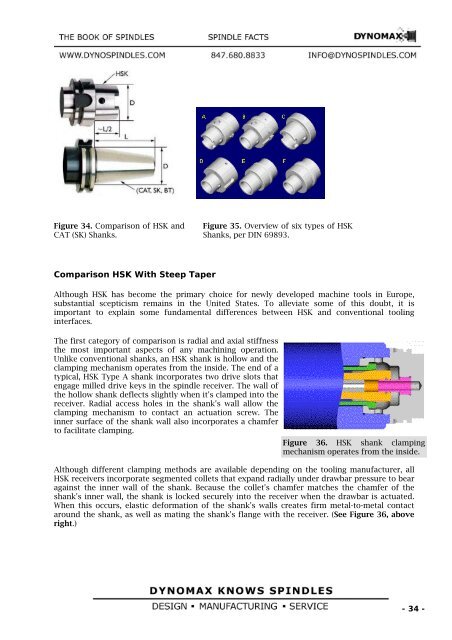Create successful ePaper yourself
Turn your PDF publications into a flip-book with our unique Google optimized e-Paper software.
Figure 34. Comparison of HSK and<br />
CAT (SK) Shanks.<br />
Comparison HSK With Steep Taper<br />
Figure 35. Overview of six types of HSK<br />
Shanks, per DIN 69893.<br />
Although HSK has become the primary choice for newly developed machine tools in Europe,<br />
substantial scepticism remains in the United States. To alleviate some of this doubt, it is<br />
important to explain some fundamental differences between HSK and conventional tooling<br />
interfaces.<br />
The first category of comparison is radial and axial stiffness<br />
the most important aspects of any machining operation.<br />
Unlike conventional shanks, an HSK shank is hollow and the<br />
clamping mechanism operates from the inside. The end of a<br />
typical, HSK Type A shank incorporates two drive slots that<br />
engage milled drive keys in the <strong>spindle</strong> receiver. The wall of<br />
the hollow shank deflects slightly when it's clamped into the<br />
receiver. Radial access holes in the shank's wall allow the<br />
clamping mechanism to contact an actuation screw. The<br />
inner surface of the shank wall also incorporates a chamfer<br />
to facilitate clamping.<br />
Figure 36. HSK shank clamping<br />
mechanism operates from the inside.<br />
Although different clamping methods are available depending on the tooling manufacturer, all<br />
HSK receivers incorporate segmented collets that expand radially under drawbar pressure to bear<br />
against the inner wall of the shank. Because the collet's chamfer matches the chamfer of the<br />
shank's inner wall, the shank is locked securely into the receiver when the drawbar is actuated.<br />
When this occurs, elastic deformation of the shank's walls creates firm metal-to-metal contact<br />
around the shank, as well as mating the shank's flange with the receiver. (See Figure 36, above<br />
right.)<br />
- 34 -



